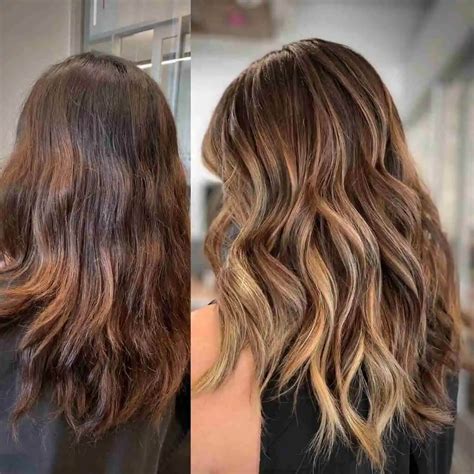Table of Contents

- Balayage Techniques
- Partial Balayage
- Full Balayage
- Comparison of Partial and Full Balayage
- Pain Points and Motivations
- Effective Strategies
- Benefits of Balayage
Balayage Techniques
Balayage, a French word meaning “to sweep,” is a hair coloring technique that creates natural-looking, sun-kissed highlights. It involves painting bleach or hair color onto the hair in a sweeping motion, creating soft, blended gradients of color.
Partial Balayage
Partial balayage is a technique that focuses on highlighting select sections of the hair, typically the ends or the face-framing layers. It’s a great option for those who want to add subtle dimension and brightness to their hair without dramatically changing their overall look.
Benefits of Partial Balayage:
- Natural-looking results: Partial balayage creates soft, blended highlights that mimic the natural effects of sun exposure.
- Low maintenance: The subtle nature of partial balayage means less frequent touch-ups compared to full balayage.
- Versatile: Partial balayage can be customized to suit individual preferences, from adding a few subtle streaks to creating more pronounced highlights.
Full Balayage
Full balayage, also known as “root-to-tip” balayage, involves painting highlights throughout the entire head of hair, from the roots to the ends. It creates a more dramatic, sun-kissed effect than partial balayage.
Benefits of Full Balayage:
- Dramatic results: Full balayage transforms the overall look of the hair, creating a bold and eye-catching statement.
- Adds volume: The lighter color streaks create the illusion of fullness and volume, especially for those with fine or thin hair.
- Long-lasting: Full balayage blends well with natural hair growth, making it a low-maintenance option in the long run.
Comparison of Partial and Full Balayage
Table 1: Partial vs. Full Balayage
| Feature | Partial Balayage | Full Balayage |
|---|---|---|
| Coverage | Select sections | Entire head of hair |
| Intensity | Subtle highlights | Dramatic highlights |
| Maintenance | Infrequent touch-ups | More frequent touch-ups |
| Cost | Typically less expensive | More expensive |
Pain Points and Motivations
Pain Points
- Damage: Balayage involves bleach or hair color, which can potentially damage hair if not performed properly.
- Time and cost: Full balayage can be time-consuming and expensive, especially for those with long or thick hair.
Motivations
- Natural-looking color: Balayage creates sun-kissed highlights that blend seamlessly with natural hair.
- Personalized results: Balayage can be customized to suit individual preferences and hair textures.
- Low maintenance: Partial balayage, in particular, offers a low-maintenance option for those who want to maintain their highlights without frequent touch-ups.
Effective Strategies
- Professional consultation: Seek advice from an experienced stylist to determine the best balayage technique for your hair type and desired results.
- Proper aftercare: Use high-quality hair care products specifically formulated for color-treated hair to prevent damage and maintain vibrancy.
- Regular trims: Trim split ends regularly to keep your hair healthy and prevent further damage.
Benefits of Balayage
- Natural-looking results: Balayage creates soft, blended highlights that mimic the effects of natural sun exposure.
- Versatile: Balayage can be customized to suit a wide range of hair colors, textures, and lengths.
- Low maintenance: Partial balayage, in particular, requires less frequent touch-ups than traditional highlights.
- Adds dimension and depth: Balayage creates a multi-dimensional, layered effect that adds depth and interest to the hair.
- Enhances volume: Lighter color streaks created by balayage can help create the illusion of fullness and volume.
Table 2: Balayage Benefits
| Benefit | Description |
|---|---|
| Natural-looking results | Creates sun-kissed highlights that blend with natural hair. |
| Versatility | Customizable to suit different hair types, textures, and lengths. |
| Low maintenance | Partial balayage requires less frequent touch-ups. |
| Adds dimension and depth | Creates multi-dimensional, layered effects. |
| Enhances volume | Lighter color streaks add fullness and interest. |
Additional Balayage Techniques
Babylights
- Ultra-fine highlights that create a natural, sun-kissed effect.
- Ideal for those who want to add subtle brightness to their hair.
Ombré Balayage
- Gradual blend of colors from dark roots to lighter ends, creating a soft, ombre effect.
- Popular for those who want a low-maintenance, beachy look.
Sombré Balayage
- Similar to ombré balayage, but with a more subtle gradient and less contrast between roots and ends.
- Ideal for those who prefer a natural, lived-in look.
Table 3: Additional Balayage Techniques
| Technique | Description |
|---|---|
| Babylights | Ultra-fine highlights for subtle brightness. |
| Ombré Balayage | Gradual blend from dark roots to lighter ends. |
| Sombré Balayage | Subtler gradient and less contrast than ombré. |
FAQs
Table 4: Balayage FAQs
| Question | Answer |
|---|---|
| How long does balayage last? | Typically 8-12 weeks, depending on hair growth and maintenance. |
| Can I do balayage at home? | Not recommended; it’s best to leave it to professionals to avoid damage. |
| Does balayage damage hair? | Yes, but proper aftercare can minimize damage. |
| How often should I get balayage touch-ups? | Frequency varies depending on technique and desired results, typically every 2-4 months. |
| Can balayage be done on all hair colors? | Yes, but results may vary depending on the starting color. |
Conclusion
Whether you choose partial or full balayage, the technique offers a versatile and natural-looking way to enhance your hair color. By working with an experienced stylist and following proper aftercare practices, you can achieve stunning results that last. Embrace the beauty of balayage and enjoy the sun-kissed highlights you’ve always dreamed of.
